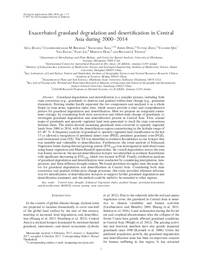Exacerbated grassland degradation and desertification in Central Asia during 2000–2014

Authors:
Grassland degradation and desertification is a complex process, including both
state conversion (e.g., grasslands to deserts) and gradual within-state change (e.g., greenness
dynamics). Existing studies hardly separated the two components and analyzed it as a whole
based on time series vegetation index data, which cannot provide a clear and comprehensive
picture for grassland degradation and desertification. Here we propose an integrated assessment
strategy, by considering both state conversion and within-state change of grasslands, to
investigate grassland degradation and desertification process in Central Asia. First, annual
maps of grasslands and sparsely vegetated land were generated to track the state conversions
between them. The results showed increasing grasslands were converted to sparsely vegetated
lands from 2000 to 2014, with the desertification region concentrating in the latitude range of
43–48° N. A frequency analysis of grassland vs. sparsely vegetated land classification in the last
15 yr allowed a recognition of persistent desert zone (PDZ), persistent grassland zone (PGZ),
and transitional zone (TZ). The TZ was identified in southern Kazakhstan as one hotspot that
was unstable and vulnerable to desertification. Furthermore, the trend analysis of Enhanced
Vegetation Index during thermal growing season (EVITGS) was investigated in individual zones
using linear regression and Mann-Kendall approaches. An overall degradation across the area
was found; moreover, the second desertification hotspot was identified in northern Kazakhstan
with significant decreasing in EVITGS, which was located in PGZ. Finally, attribution analyses
of grassland degradation and desertification were conducted by considering precipitation, temperature,
and three different drought indices. We found persistent droughts were the main factor
for grassland degradation and desertification in Central Asia. Considering both state
conversion and gradual within-state change processes, this study provided reference information
for identification of desertification hotspots to support further grassland degradation and
desertification treatment, and the method could be useful to be extended to other regions
